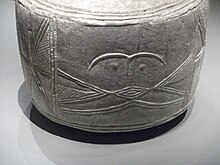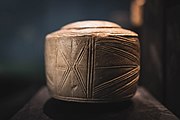Folkton Drums
| Folkton Drums | |
|---|---|
 Folkton Drums displayed in the British Museum | |
| Material | Chalk |
| Size | 8.7 cm (height) |
| Created | 2600–2100 BC |
| Discovered | 1889 |
| Present location | British Museum |
| Identification | P&EE 1893 12-28 15-17 |
The Folkton Drums are a very rare set of three decorated chalk objects in the shape of drums or solid cylinders dating from the Neolithic period. Found in a child's grave near the village of Folkton in northern England, they are now on loan to Stonehenge Visitor Centre from the British Museum.[1] A similar object, the Burton Agnes drum was found 15 miles away near Burton Agnes in 2015,[2] and another example, the Lavant drum, was excavated in 1993 in Lavant, West Sussex.[3]
Their purpose remains obscure. They were given the name "drum" to describe their shape, rather than from any thought they might be percussion instruments.
Discovery
[edit]
In 1889, a round prehistoric barrow was opened by the scholar and amateur archaeologist William Greenwell near Folkton in North Yorkshire.[4] Inside, he found a neolithic grave dating to the time of Stonehenge, estimated to be between 2600 and 2000 BC. The remains of several bodies were unearthed, one of whom was a child beside which the three drums were found. The rarity of this find suggests that the child came from an elite group in society. Four years after the discovery, the drums were donated by Greenwell, along with other parts of his collection, to the British Museum.[5]
Description
[edit]
The three drum-like forms are made of locally quarried chalk and are decorated with stylized human faces and geometric patterns. On the top of the cylinders are a series of concentric circles and two of them have pairs of eyes that schematically denote a human face. The decoration of the drums has similarities to objects made in the Beaker culture and early British Bronze Age, including the use of chevron and lozenge forms.[6][7]
Mathematics
[edit]A study published in 2018 noted that the circumferences of the drums form whole-number divisions (ten, nine and eight times, respectively) of ten long feet, a unit of measure thought to have been widely used in Neolithic Britain.[8] The drums could therefore have been used as measuring devices, as a means of achieving standardisation in construction at different locations.[9][10] The diameters, and hence the circumferences, of the drums also form a mathematical harmonic sequence.[11] According to author Prof. Andrew Chamberlain, "The existence of these measuring devices implies an advanced knowledge in prehistoric Britain of geometry and of the mathematical properties of circles.”[8]
The study also proposed that the drums represent ceremonial objects that have uniquely survived due to their unusual material, while most objects of this type may have been made out of wood.[8] The Lavant drum, excavated in 1993, was previously identified as being analogous to the Folkton drums in 2005 by archaeologist Anne Teather.[12]
Legacy
[edit]Children's writer and poet Michael Rosen wrote a poem "Folkton Drums" in 2018 in connection with the University of Reading's Grave Goods project.[13][14]
Display
[edit]The three Folkton drums were displayed as part of the 2022 World of Stonehenge exhibition at the British Museum, alongside the Burton Agnes Drum, which was in the public view for the first time.[15][16]
Gallery
[edit]-
View of another face with prominent features
-
Alternative view of the three drums
-
Another view
-
BM guide, 1904
-
BM guide, 1904
See also
[edit]References
[edit]- ^ "The Folkton Drums". The British Museum. Retrieved 24 April 2021.
- ^ "Ancient chalk sculpture is 'most important prehistoric art'". BBC News. 10 February 2022. Retrieved 11 February 2022.
- ^ "The Novium Museum - Lavant Neolithic Chalk Drum". www.thenovium.org. Retrieved 11 February 2022.
- ^ North, John (1996). Stonehenge : a new interpretation of prehistoric man and the cosmos. New York, NY: The Free Press. ISBN 1416576460. Retrieved 31 July 2014.
- ^ Garrow, Duncan; Wilkin, Neil (2022). The World of Stonehenge. London: British Museum Press. p. 24. ISBN 978-07141-2349-3.
- ^ "Drum". British Museum Collection Online. 2022.
- ^ Gerloff, Sabine (2007). "Reinecke's ABC and the Chronology of the British Bronze Age". In Burgess, Christopher; Topping, Peter; Lynch, Frances (eds.). Beyond Stonehenge: Essays on the Bronze Age in Honour of Colin Burgess. Oxbow Books. pp. 117–161. ISBN 978-1-84217-215-5.
Megalithic-style linear motifs – including chevrons and lozenges – reappeared in the earliest Bronze Age, when they are found on British long-necked beakers from single burials and are also characteristic of the most prestigious metalwork, namely Irish gold lunulae. These motifs – or better 'symbols' – continued into the time of the Wessex Culture, when they made their appearance in the shape and decoration of the prestigious Bush Barrow and Clandon breastplates and the gold-nail inlay of the Bush Barrow hilt and its associated bone mounts. … The survival of these motifs or symbols associated with burials, rituals and elites must indicate a continuation of some Megalithic traditions, beliefs and cult practices into the Early Bronze Age.
- ^ a b c UCL (21 December 2018). "Folkton Drums could have been measuring devices used to build Stonehenge". UCL News. Archived from the original on 28 January 2019. Retrieved 9 December 2019.
- ^ Teather, Anne; Chamberlain, Andrew; Parker Pearson, Mike (2018). "The chalk drums from Folkton and Lavant: Measuring devices from the time of Stonehenge" (PDF). British Journal for the History of Mathematics. 34 (1): 1–11. doi:10.1080/17498430.2018.1555927. S2CID 189372696.
we propose that there is a direct link between the design of the monument of Stonehenge and the chalk artefacts known as the Folkton and Lavant Drums, in which the Drums represent measurement standards that were essential for accurate and reproducible monument construction.
- ^ Teather, Anne; et al. (8 February 2019). "Getting the Measure of Stonehenge". British Archaeology (165): 48–51.
- ^ Teather, Anne; Chamberlain, Andrew; Parker Pearson, Mike (2018). "The chalk drums from Folkton and Lavant: Measuring devices from the time of Stonehenge" (PDF). British Journal for the History of Mathematics. 34 (1): 1–11. doi:10.1080/17498430.2018.1555927. S2CID 189372696.
The diameters, and hence the circumferences, of these four drums form a mathematical harmonic sequence
- ^ Kenny, James; Teather, Anne M. (2016). "New insights into the Neolithic chalk drums from Folkton (North Yorkshire) and Lavant (West Sussex)". PAST: The Newsletter of the Prehistoric Society. 83: 5–6. Includes full text of poem
- ^ "Death, memory, meaning". The British Museum. Retrieved 12 February 2022.
- ^ "Objects and death: three burials across time". Connecting Research. University of Reading. 24 May 2019.
- ^ "Story of Stonehenge to be told in major British Museum exhibition". The Guardian. 7 December 2021. Retrieved 27 March 2022.
- ^ "The world of Stonehenge". The British Museum. Retrieved 27 March 2022.
Bibliography
[edit]- H. Longworth, 'The Folkton Drums unpicked' in Grooved Ware in Britain and Ireland, Neolithic Studies Group Seminar Papers 3 (Oxford, Oxbow Books, 1999), pp. 83–88
- D. V. Clarke, T. G. Cowie and A. Foxon, Symbols of power at the time of Stonehenge (London, HMSO, 1985)
- I. A. Kinnes and I. H. Longworth, Catalogue of the excavated Prehistoric and Roman-British material in the Greenwell Collection (London, The British Museum Press, 1985)





